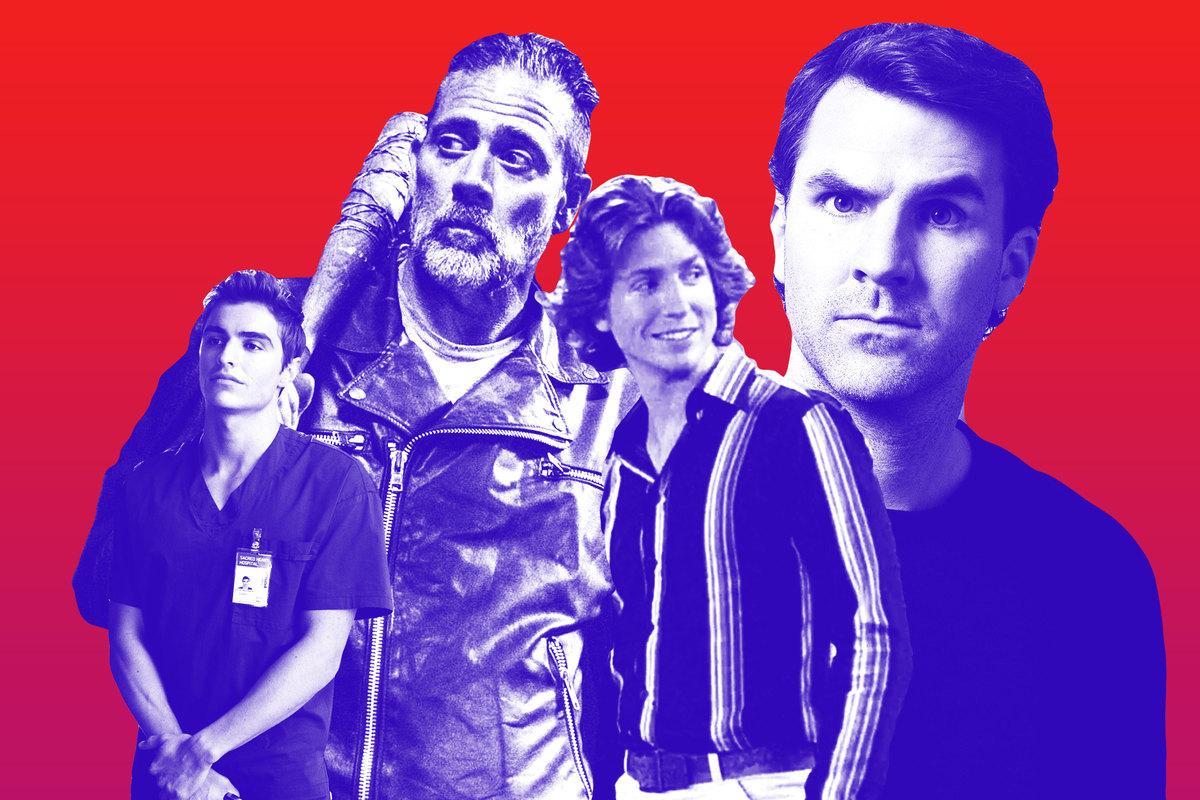
As the lengthy list of snubs in The Ringer’s Best TV Character Bracket can attest, we’ve had no shortage of memorable television personalities this century. Our finalized, 64-character bracket covers a broad spectrum of programs and personalities—from classic Golden Age antiheroes to heartthrobs to serial killers to literal royalty and everything in between. Readers may quibble over the seeding, the snubs, and who will ultimately win this thing, but I’d argue the idea of the bracket itself is foolproof because there are so many awesome characters to choose from. (And please, let’s not take the competition that seriously: This is silly, arbitrary, and fun—the definition of Quarantine Goals.)
But in the era of Peak TV, you don’t make countless hours of scripted programming without having a few misfires—and creating a few characters who’ll forever live in ignominy. Even the best shows can disrupt their mojo with an ill-advised character introduction; in honor of one of the OG shitty characters, let’s call it the Cousin Oliver effect. In some of these cases, a bad TV character (or several) is enough to ruin a show—in others, their exit created an opportunity for a series to start firing on all cylinders.
With so many Ringer colleagues commemorating television characters and performances worth remembering, I felt it was my duty to make sure we also celebrated (roasted?) some of the ones we wish we could forget. The same way sports fans will always recall the worst contracts their teams dished out—shout-out Gilbert Arenas, John Wall, and the still-lingering incompetence of Ernie Grunfeld—TV viewers can never set aside the worst of the worst. These are the top characters from this century in television that are worthy of this dubious honor.
Randy Pearson, That ’70s Show
In what’ll become a familiar theme on this list, That ’70s Show tried to make up for losing original cast members in its final season by introducing a character with similar quirks. Originally, Josh Meyers was going to replace Topher Grace as Eric Forman—Grace was off working on projects like Spider-Man 3; obviously worth it—but the sitcom instead created a new character for the actor in Randy, who was supposed to be a mix of Eric and Kelso (Ashton Kutcher), who also left partway through the season.
But Randy never stood a chance. His relationship with Donna (Laura Prepon) was a bland facsimile of her dynamic with Eric, and didn’t have any of the years of chemistry and audience investment. Randy also didn’t really vibe with anyone else in the cast, his jokes never landed, and the closest thing he had to an original personality trait was “long hair.” By That ’70s Show’s series finale, Grace’s Eric made a cameo to give the show a proper sendoff—if you’ve forgotten that Randy even showed up in that episode, well, that was kind of the point.
Dana Brody, Homeland
If there’s one thing the television industry is dependably terrible at, it’s writing teenagers—and kids in general. Last year, we had a whole bracket dedicated to annoying TV kids. But while some TV kids’ annoyingness elevated a show’s material—The Sopranos wouldn’t be the same without A.J. Soprano being an absolute moron—Homeland’s Dana Brody did the opposite.
Poor Morgan Saylor—who received a bulk of the hate that should be reserved for the show’s writing staff—was trapped in an endless vortex of sulking and oversized flannels, as Homeland kept circling the drain. (Can you believe her father, Nick Brody, was killed off in Season 3, and yet Homeland is STILL ON THE AIR?!) Dana’s scenes were increasingly pointless and redundant, and it was a small mercy when the series finally cut the Brody clan loose to tackle threats to national security that didn’t overlap with teen hormones. At least before that happened we were blessed with an elite Saturday Night Live skit that parodied the show’s increasingly bonkers material.
Negan, The Walking Dead
In an alternate universe, maybe the introduction of Negan would’ve propelled The Walking Dead to even greater heights—when the character showed up in the Season 6 finale, it was among the highest-rated shows on TV. On paper, this should’ve been lit: Negan is considered by most fans of the eponymous comics series to be its most iconic villain, and Jeffrey Dean Morgan looked like he was put on this earth for the role. But nothing that went wrong with Negan falls on the actor’s shoulders; instead, it was the baffling choice to turn the villain’s appearance into a grueling, unnecessary, months-long cliff-hanger.
The sixth season ends with Negan clobbering an unknown member of Rick Grimes’s group with his infamous baseball bat—the show waited until the Season 7 premiere to show who, exactly, was on the receiving end, much to the consternation of fans. Cliff-hangers aren’t bad in and of themselves, but this wasn’t exactly delayed gratification: It served only to draw out what was a shockingly violent end for Abraham and fan favorite Glenn. The Walking Dead will never be mistaken for cheery television, but up until that point it wasn’t torture porn, either. Viewers responded with a mass exodus. Since then, the series has, against all odds, found a way to somewhat recapture its old form. Unfortunately, The Walking Dead will probably never recover from proverbially beating itself over the head.
Mark Brendanawicz, Parks and Recreation
Parks and Rec really started hitting its stride once Ben Wyatt (Adam Scott) and Chris Traeger (Rob Lowe) arrived at the end of the second season, but this swing of momentum also coincided with the quiet exit of Paul Schneider’s Mark Brendanawicz. Mark was originally set up as a potential love interest for Leslie Knope (Amy Poehler) before latching on to Ann Perkins (Rashida Jones) in Season 2, but even Schneider admits to struggling to find a purpose for the character. Mark was lazy and cynical about government work, but not in an eccentric way like Ron Swanson (Nick Offerman), and he didn’t have the deadpan humor to match April Ludgate (Aubrey Plaza). He was a little bit of everything and a lot of nothing.
But I think the key to why Mark didn’t work for Parks and Rec—and why he’s one of the few characters who didn’t cameo in the final season, nor was he ever mentioned again after he left—is how the show shifted its loyalty to Leslie. In the first season, the series seemed to take the cynic’s view of Pawnee, Indiana, mocking Leslie for having all this faith in the town and government institutions. (Seriously, if you rewatch Season 1 you’ll notice how dour Parks and Rec feels compared to where it ended up.) But as Leslie’s optimism injected itself into all parts of the show, there was no room for a character like Mark, who was there only to weigh down her ambitions. And when Parks and Rec straight-up ends with Leslie ascending to POTUS, Mark was never gonna work in the long run. That the character and the show’s conscious uncoupling happened so early made the best of a bad situation.
The Sand Snakes, Game of Thrones
We know who’s really responsible for Game of Thrones falling apart—hint: they just had a cringeworthy cameo on Westworld—but perhaps the earliest sign that the show might not be able to stick the landing was when it bungled the entry of the Sand Snakes and Dorne in Season 5. The bastard daughters of Oberyn Martell—there are eight in George R.R. Martin’s book series, but the show trimmed the group down to three (or four, technically, though the fourth Sand Snake was only mentioned)—were billed as infamous warriors, but in three inconsistent seasons, they barely had the chance to show off their so-called skills. One of the few times the Sand Snakes actually killed someone, it was a stabbing from behind. Are you kidding me?!
In retrospect, the introduction and development of the Sand Snakes was a warning of what Thrones would become—plotlines were increasingly rushed, characters jumped all over Westeros with no regard to time or space, and inexplicable decisions were made by leaders who should’ve known better. Is it too late for Netflix to back out of handing David Benioff and D.B. Weiss a $200 million deal?
Tuan, The Americans
Please, Americans-hive, before you attack me: I have always gone to bat for this awesome show. It is only because I have such high standards for one of the best series of the century that I am making this complaint. I think even the most ardent corner of Americans fandom would concede the penultimate season sputtered a bit— subplots centered on wheat and Russian grocery stores will test your patience for dry material. Another piece of the Americans Season 5 puzzle that never quite fit was the one-season arc of Tuan (Ivan Mok), the Vietnamese spy who partnered with the Jenningses and posed as their adopted child.
On paper, everything with Tuan was interesting for the ways he reflected the moral descent of the Jenningses. He was a mirror for Elizabeth (Keri Russell) and represented what she would be if she gave up all her humanity for the sake of the missions, and he was also what the Jenningses risked turning their daughter Paige (Holly Taylor) into by involving her in the family “business.” Tuan was, in short, a little monster. But for all the ways Tuan worked in tandem with the Jenningses, he never felt like a fully realized character himself. He worked only in service of the protagonists. On a series as great as The Americans, that made Tuan an outlier—and a weak link.
Lumberjack Dexter Morgan, Dexter
Dexter Morgan (apologies to Michael C. Hall) is pulling double duty this week. He appeared in our Best TV Characters bracket and lost in his first-round matchup to Mad Men’s Don Draper. While there’s no shame in losing to a legend like Don, the serial killer’s reputation has arguably suffered more than any other character in the initial bracket. Dexter isn’t the only good show that shat the bed with its series finale, but few can claim to be as terrible.
Rest assured, the Dexter finale is as dumb as you remembered—I still don’t think we, as a society, have grasped just how bad it was. If you’ll recall, it appeared that Dexter died in the middle of a hurricane after dumping his deceased sister Deb’s body out to sea. But no, sorry, somehow Dexter actually survived the hurricane and began hiding in the Pacific Northwest as a lumberjack, in a futile attempt by Showtime to keep the dream of a Dexter spinoff alive. There were some genuinely great seasons of Dexter, and Hall gave a riveting and literally Golden Globe–winning performance. Sadly, when it comes to Dexter and the character’s legacy, all roads lead to the plaid.
Dawn Summers, Buffy the Vampire Slayer
Imagine watching Buffy the Vampire Slayer for four seasons, and when the Season 5 premiere hits, everyone is acting like Buffy (Sarah Michelle Gellar) always had a younger sister, despite said character never being seen or mentioned before. Initially, the introduction of Dawn Summers (Michelle Trachtenberg) looked like an all-time baffling retcon that’d make The Rise of Skywalker seem sensible—the truth was a lot more perplexing. Dawn was actually a MacGuffin in human form: a mystical form of energy that was also a “key” capable of unlocking other dimensions. The protectors of this energy turned her into Dawn, hoping Buffy would keep the key safe from the hell goddess Glorificus. (I am indoctrinated into the perfect and wild world of Buffy, which in the following season did a kickass musical, so it was easier for me to roll with this stuff than you’d think.)
The problem with Dawn wasn’t the convoluted way the character latched on to the show, but what little she added after the fact. She hit the familiar angsty teen notes—at a time when Buffy outgrew that kind of material as the Scooby Gang navigated the trials of adulthood. It felt trivial, and frankly, annoying—who cares about Dawn’s shoplifting habit when her sister is trying to save the fucking world from the supernatural and hold down a regular job?! Dawn didn’t derail one of the best shows ever made, but her inclusion didn’t unlock anything special in the series, either.
All the newcomers at the end of Scrubs
There are [clears throat] some colleagues who think Scrubs hasn’t gotten the respect it deserves on this website. (For what it’s worth, I have watched Scrubs’ Toto’s “Africa” sequence more times than I can count.) But maybe one of the reasons Scrubs isn’t regarded as highly as other sitcoms is the bland and forgettable final season. ABC tried Frankenstein-ing the show in Season 9: The only cast members who stayed on as series regulars were Donald Faison and John C. McGinley, as Dave Franco, Kerry Bishé, and Michael Mosley came on as the show’s new central trio within Sacred Heart’s medical school.
New Scrubs ended up being such a misfire that creator Bill Lawrence wants to pretend it didn’t exist, going so far as to treat the season like a failed spinoff so that the Season 8 finale would count as the real end to his show. Thankfully, everyone seemed to come out of this mess in a good place: Franco, Bishé, and Mosley have all put together solid careers; Faison, McGinley, and the rest of the Scrubs alums can keep collecting those sweet residual checks; Zach Braff, much to everyone’s dismay, is still dating Florence “MAH WIFE” Pugh. Erasing Scrubs Season 9 from our collective memory is sound medical advice.

